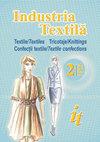An eco-friendly approach: effect of fixation time on colour and comfort properties of digital printed fabric
IF 0.9
4区 工程技术
Q3 MATERIALS SCIENCE, TEXTILES
引用次数: 0
Abstract
This study will examine how digital printing affects clothing comfort on knitted fabrics from different raw materials. Garments significantly affect the heat exchange between the human body and the environment. Therefore, consumers prefer thermally balanced and effective moisture-controlled products in the selection of clothing. Air permeability is also important in explaining the comfort performance of the product in the textile industry. On the other hand, digital printing machines have become the centre of attention of consumers as a print type on which the desired pattern can be printed on the chosen fabric and more ecological, faster, and economical. However different printing processes can change the comfort characteristics of the garments. In this study, single jersey knitted fabrics 100% Ne 12/1 cotton, 100% Ne 30/1 cotton, and Ne 12/1 70% cotton + 30% Hemp were produced. Raw materials were bleached and singed, then coloured with digital printing. After that, air permeability, bursting strength, stiffness, ironing fastness, and SEM analyses were applied to samples when the results were determined, it was seen that heavier fabric will have higher stiffness. Also, thicker yarns have higher bursting strength. It follows that the cotton-hemp blended fibres (PK) have high unevenness, and the bursting strength of the fabrics produced from this raw material is lower than cotton fabrics (P12). Similarly, since the thin-thick place values of cotton-hemp blended yarns are high, porosity is one of the most important factors affecting air permeability in fabrics. This porous structure also increased the air permeability of the fabric.一种环保方法:固定时间对数码印花织物色彩和舒适性能的影响
本研究将探讨数码印花如何影响不同原料针织面料的服装舒适度。服装显著影响人体与环境之间的热交换。因此,消费者在选择服装时更喜欢热平衡、有效控湿的产品。透气性在解释纺织行业产品的舒适性能方面也很重要。另一方面,数码印花机已成为消费者关注的中心,因为它可以在选定的织物上印刷所需的图案,而且更生态、更快、更经济。然而,不同的印刷工艺可以改变服装的舒适特性。本研究生产了100% ne12 /1棉、100% ne30 /1棉和ne12 /1 70%棉+ 30%麻的针织单品织物。原材料被漂白和烧焦,然后用数码印刷着色。然后对样品进行透气性、破裂强度、刚度、熨烫牢度和SEM分析,结果确定后,织物越重,其刚度越高。而且,纱线越粗,断裂强度越高。由此可见,棉麻混纺纤维(PK)的不均匀度较高,用该原料生产的织物的抗破裂强度低于棉织物(P12)。同样,由于棉麻混纺纱线的薄厚值较高,因此孔隙率是影响织物透气性的重要因素之一。这种多孔结构也增加了织物的透气性。
本文章由计算机程序翻译,如有差异,请以英文原文为准。
求助全文
约1分钟内获得全文
求助全文
来源期刊

Industria Textila
工程技术-材料科学:纺织
CiteScore
1.80
自引率
14.30%
发文量
81
审稿时长
3.5 months
期刊介绍:
Industria Textila journal is addressed to university and research specialists, to companies active in the textiles and clothing sector and to the related sectors users of textile products with a technical purpose.
 求助内容:
求助内容: 应助结果提醒方式:
应助结果提醒方式:


